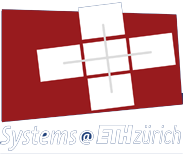Publications by Markus Pilman
2016
Proceedings of the 2016 International Conference on Management of Data, SIGMOD Conference 2016, San Francisco, CA, USA, June 2016
@inproceedings{abc,
author = {Markus Pilman and Martin Kaufmann and Florian K{\"o}hl and Donald Kossmann and Damien Profeta},
booktitle = {Proceedings of the 2016 International Conference on Management of Data, SIGMOD Conference 2016, San Francisco, CA, USA},
title = {ParTime: Parallel Temporal Aggregation.},
url = {http://doi.acm.org/10.1145/2882903.2903732},
year = {2016}
}
2015
Proceedings of the 2015 ACM SIGMOD International Conference on Management of Data, Melbourne, Victoria, Australia, June 2015
@inproceedings{abc,
author = {Simon Loesing and Markus Pilman and Thomas Etter and Donald Kossmann},
booktitle = {Proceedings of the 2015 ACM SIGMOD International Conference on Management of Data, Melbourne, Victoria, Australia},
title = {On the Design and Scalability of Distributed Shared-Data Databases.},
url = {http://doi.acm.org/10.1145/2723372.2751519},
year = {2015}
}
Proceedings of the 2015 ACM SIGMOD International Conference on Management of Data, Melbourne, Victoria, Australia, June 2015
@inproceedings{abc,
author = {Philip A. Bernstein and Sudipto Das and Bailu Ding and Markus Pilman},
booktitle = {Proceedings of the 2015 ACM SIGMOD International Conference on Management of Data, Melbourne, Victoria, Australia},
title = {Optimizing Optimistic Concurrency Control for Tree-Structured, Log-Structured Databases.},
url = {http://doi.acm.org/10.1145/2723372.2737788},
year = {2015}
}
2012
Systems Group Master's Thesis, no. 32; Department of Computer Science, February 2012
Supervised by: Prof. Donald Kossmann
Supervised by: Prof. Donald Kossmann
In today’s big scale applications, the database system has more and more evolved to the most limiting bottleneck. Unlike application servers and web servers, database systems are hard to scale. During the last few years a new generation of simpler but more scalable storage systems, often refered to as NoSQL (Not only SQL), recieved more attention. While these system often solve scalability issues, they sacrifice some fundamantal properties of traditional database systems like consistency or the data model.
This thesis presents a relational and transactional database system which uses a key-value store instead of a hard drive disk as storage. This systems provides better elasticity and scalability than traditional disk based architecures without making any compromises in the consistency guarantees. In the first part we show that a transactional database can run on top of a key-value store without any performance or scalability penalties. We implemented such a system based on MySQL and RamCloud and provide benchmarking results of this system. In a next step we explain how this system can be made scalable and how the database system needs to be changed in order to be able to run several database instances on the same storage.
@mastersthesis{abc,
abstract = {In today{\textquoteright}s big scale applications, the database system has more and more evolved to the most limiting bottleneck. Unlike application servers and web servers, database systems are hard to scale. During the last few years a new generation of simpler but more scalable storage systems, often refered to as NoSQL (Not only SQL), recieved more attention. While these system often solve scalability issues, they sacrifice some fundamantal properties of traditional database systems like consistency or the data model.
This thesis presents a relational and transactional database system which uses a key-value store instead of a hard drive disk as storage. This systems provides better elasticity and scalability than traditional disk based architecures without making any compromises in the consistency guarantees. In the first part we show that a transactional database can run on top of a key-value store without any performance or scalability penalties. We implemented such a system based on MySQL and RamCloud and provide benchmarking results of this system. In a next step we explain how this system can be made scalable and how the database system needs to be changed in order to be able to run several database instances on the same storage.},
author = {Markus Pilman},
school = {32},
title = {Running a transactional Database on top of RamCloud},
year = {2012}
}
2009
Proceedings of the 18th International Conference on World Wide Web, WWW 2009, Madrid, Spain, January 2009
@inproceedings{abc,
author = {Ghislain Fourny and Markus Pilman and Daniela Florescu and Donald Kossmann and Tim Kraska and Darin McBeath},
booktitle = {Proceedings of the 18th International Conference on World Wide Web, WWW 2009, Madrid, Spain},
title = {XQuery in the browser.},
url = {http://doi.acm.org/10.1145/1526709.1526845},
year = {2009}
}
2008
Proceedings of the ACM SIGMOD International Conference on Management of Data, SIGMOD 2008, Vancouver, BC, Canada, January 2008
@inproceedings{abc,
author = {Ghislain Fourny and Donald Kossmann and Tim Kraska and Markus Pilman and Daniela Florescu},
booktitle = {Proceedings of the ACM SIGMOD International Conference on Management of Data, SIGMOD 2008, Vancouver, BC, Canada},
title = {XQuery in the browser.},
url = {http://doi.acm.org/10.1145/1376616.1376769},
year = {2008}
}

